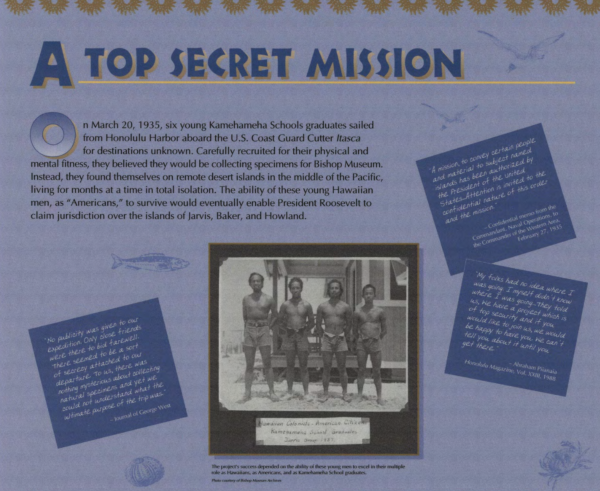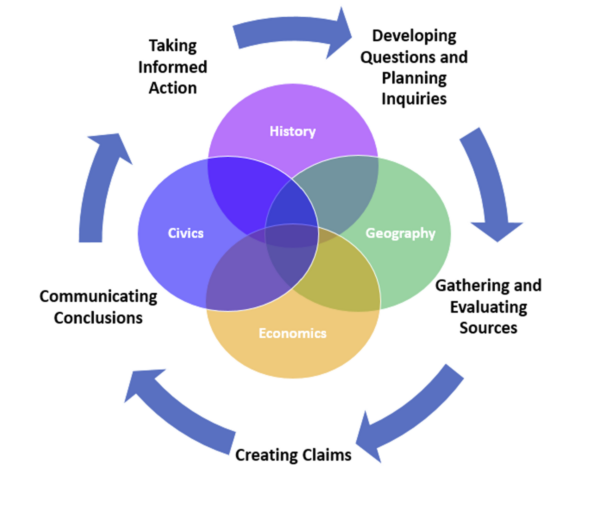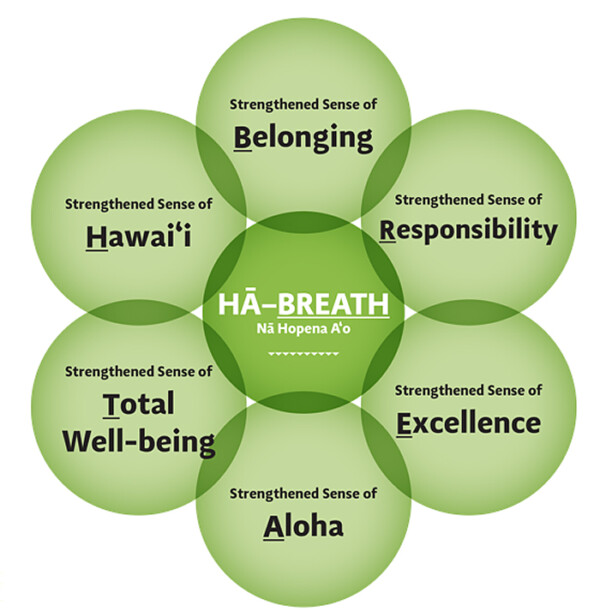Values, Culture and Experiences
How did the cultures and backgrounds of these young men help them survive and thrive on remote Pacific Islands?
What values, practices, knowledge and experiences helped them succeed in working together as a team?
How just were the U.S. government’s cultural assumptions, decisions and implementation of the mission, within the context of critical pre-WWII strategic need?
Informed Decision Making
How do these young men’s stories of real-world experiences and sometimes fatal consequences, affect and impact us today?
What can we learn from these historical stories about Hawaiian cultural values, and how to apply them to present day problem solving in our comunities and society today?
How does healthy skepticism, reading various sources, and exploring different sides of a story, help youth avoid “clickbait” and encourage respect for one another in life and online?
Lesson 1
What is my connection to Hui Panala'au?Lesson 1
Who are the young men of Hui Panalāʻau, and how did this name come about?
What was this secret mission, and why did the U.S. government undertake it? What were these young men told, if anything at all?
When did this take place, and what was happeing in the U.S., Hawaiʻi, the more remote Pacific, and globally at the time?
Where are these remote Pacific Islands located and what was the importance of their location during this time period for the U.S.?
Lesson 2
How does culture play roles in human-environment interactions and social organization?Lesson 2
How did the cultures and upbringings of these young men play a role with their ability to survive and thrive on these remote Pacific Islands?
What values, practices, mindsets, knowledge, and prior experiences helped them on this journey and gave them the ability to work together successfully?
How might these stories of Hui Panalāʻau help us to develop empathy, become grounded in key Hawaiian cultural values, and solve problems in our community and greater society?
High School Lesson
How might storytelling be used to remember the past, build connections to people and ʻāina, and perpetuate knowledge and truths as retold in these stories?High School Lesson
How do the experiences of the Hui Panalāʻau colonists, including the deaths of young men, impact us today?
What aspects of the story told by first person narratives and observational perspectives of Hui Panalāʻau colonists, are morally or ethically just? Can there be multiple truths?
As the story of Hui Panalāʻau continues to unfold, how do we address the wrongs and injustices that took place in the 1930s and 40s?
The Hawaiʻi Core Standards in Social Studies (HCSSS) outline the content, concepts, and inquiry skills students need to reason, wonder, and think about the vastness and richness of the human condition. They integrate and encompass the democratic values, civility, and global perspective needed to support the development of critical thinking and habits of mind that are the hallmark of a mature, community-minded citizen.
Our lessons for middle school students use the inquiry cycle of the HCSSS College, Career, & Civic Life C3 Framework, a national framework emphasizing the inquiry process to spark natural curiosity, guide instruction, deepen investigations, acquire rigorous content, and apply knowledge in real world settings as informed and engaged citizens in college, career, and civic life.
We use the framework in our lessons, as a foundation for deepening the understanding of civics, economics, history, and geography that drives the curriculum for the Hui Panalaau mission from 1935-1942.
Nā Hopena Aʻo Connections
Our lessons also align with the Hawaii Department of Education’s Nā Hopena Aʻo framework with the six outcomes that are firmly rooted in Hawaiʻi, but are values universal to all cultures. Teaching within this context adds value to and strengthens each and every person who engages over the course this learning journey.
|
Hopena End goals, the result of an action |
Aʻo Learning and teaching |
The Hawaiʻi Department of Educationʻs framework honoring the qualities and values of the Indigenous language and culture of Hawaiʻi were exemplified in the colonists who showed cultural pride and a strong sense of self-identity, and who were able to “thrive under adverse conditions with humor, grace, and humility” (Kahanu, 2002, p. xxxii).
Strengthened Sense of Belonging
He pili wehena ʻole A relationship that cannot be undone
I stand firm in my space with a strong foundation of relationships. A sense of Belonging is demonstrated through an understanding of lineage and place and a connection to past, present, and future. I am able to interact respectfully for the betterment of self and others.
Strengthened Sense of Responsibility
Ma ka hana ka ʻike, ma ka ʻimi ka loaʻa In working one learns, through initiative one aquires
I willingly carry my responsibility for self, family, community and the larger society. A sense of Responsibility is demonstrated by a commitment and concern for others. I am mindful of the values, needs and welfare of others.
Strengthened Sense of Excellence
ʻAʻohe ʻulu e loaʻa I ka pōkole o ka lou There is no success without preparation
I believe I can succeed in school and life and am inspired to care about the quality of my work. A sense of Excellence is demonstrated by a love of learning and the pursuit of skills, knowledge and behaviors to reach my potential. I am able to take intellectual risks and strive beyond what is expected.
Strengthened Sense of Aloha
E ʻopū aliʻi Have the heart of a chief
I show care and respect for myself, families, and communities. A sense of Aloha is demonstrated through empathy and appreciation for the symbiotic relationship between all. I am able to build trust and lead for the good of the whole.
—Source: Pukui, M. (1983). ʻŌlelo Noʻeau Hawaiian Proverbs Poetical Sayings. Honolulu, Hawaii: Bishop Museum Press.
Together, the C3 Framework and HCSSS are foundational for social studies education. With this shift in purpose, and by using digital tools such as the Hui Panalāʻau Digital Library, students can undertake experiential journeys of inquiry and take informed action. Where there have been injustices, appropriations, or racially stereotyped actions in the past, we can use more thoughtful and intentional frameworks now to set things pono (morally right, or just).



